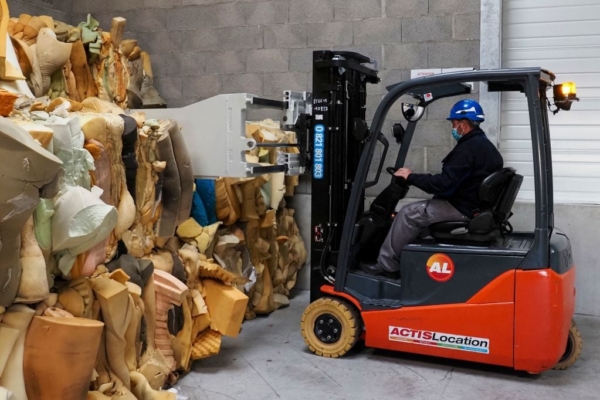Global polyurethane foam consumption continues to rise, but when these foam-made products such as mattresses and sponges are discarded, they are often buried or incinerated, leading to serious environmental pollution. Now, Danish scientists have found a better and more economical way to recycle and reuse polyurethane foam, offering a solution to the pollution problem.
Polyurethane (PUR) is a widely used polymer material composed mainly of “polyols” and “isocyanates” chemically synthesized into plastic materials. It can be used for various products such as slow-speed tires, mattresses, sponges, wind turbine blades, and cables. Global polyurethane production approached nearly 26 million tons in 2022 and is projected to reach 31.3 million tons by 2030.
Traditional PUR recycling methods are inefficient mainly because PUR is a thermosetting material that cannot be reused through conventional heating or reshaping. Most often, it can only be mechanically crushed and bonded through the addition of isocyanates for recycling. However, the effectiveness of these recycling methods is limited, ultimately resulting in either burial or incineration.
Moreover, most chemical PUR recycling efforts have focused on the disassembly of soft PUR. This is because many commercial soft PUR foam products are copolymers based on different isocyanates and polyols compositions, but separating these products can lead to the generation of toxic substances.
Researchers at Aarhus University in Denmark, with nearly a century of history, have developed a new method using an “acidolysis process” to effectively separate soft polyurethane foam into reusable raw materials. Their research results were published in the journal “Green Chemistry” at the end of June.
The key to the “acidolysis process” used by the researchers lies in succinic acid, which is utilized as a disassembling agent for polymers. Succinic acid can efficiently break down soft PUR foam into methylene diphenyl diisocyanate succinimide, which is then further processed through hydrolysis or ruthenium metal-catalyzed hydrogenation to obtain diphenylamine (TDA) and polyols.
Both substances can be used to produce new PUR materials, and TDA can be used to reproduce new isocyanates, making the entire process highly beneficial for recycling.
The choice of succinic acid is also based on its natural and easily obtainable properties as an acid commonly used in food additives and plastics manufacturing. It can also act as a substance for certain biodegradable polymers and has been shown to react with PUR without the need for additional chemicals.
During the experimental process, the researchers first immersed the soft PUR foam in a succinic acid environment for easy separation of the polyols inside. They then used a sodium hydroxide solution for alkaline hydrolysis to obtain TDA-related substances, releasing a significant amount of non-toxic carbon dioxide in the process.
This method achieved a recovery rate of polyols and TDA of up to 83%, comparable to the effectiveness of commercial adhesive recycling methods using chemicals.
Furthermore, the researchers tested applying this technology to hard polyurethane foam to explore whether the method can be expanded to other types of polyurethanes. The results showed a lower recovery rate compared to soft PUR foam, only being able to recover a portion of the raw materials. However, initial findings suggest the method has potential and requires further refinement.
Hard polyurethane foam, constituting 25% of the entire polyurethane market, is a complex and difficult-to-recycle material commonly used in refrigerators, homes, and insulation around residential district hot water steel pipes.
Assistant Professor Steffan Kvist Kristensen from the Interdisciplinary Nanoscience Center (iNANO) at Aarhus University stated that the method is easily scalable but further research is required to handle PUR waste from consumers. While there is still a long way to go to enter the circular economy, the progress made is promising.

